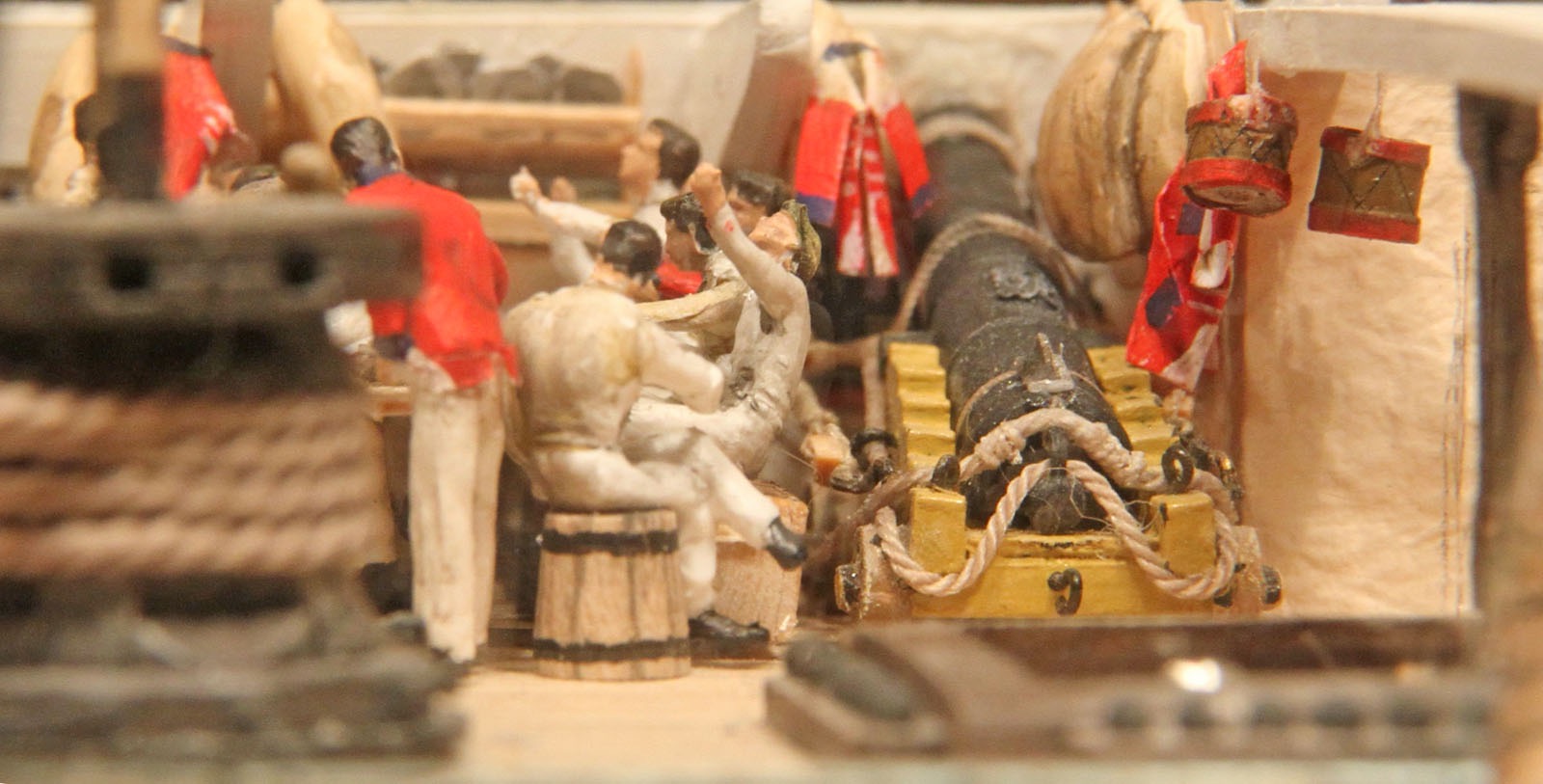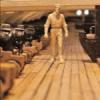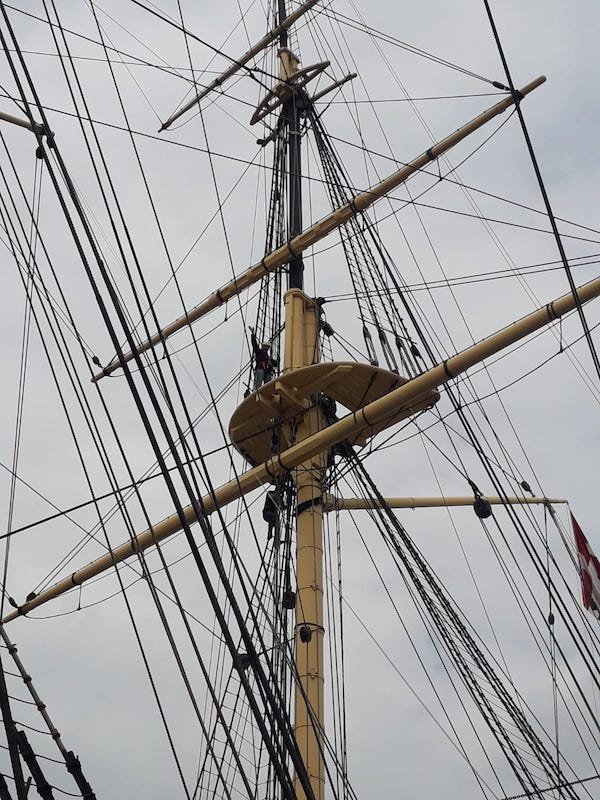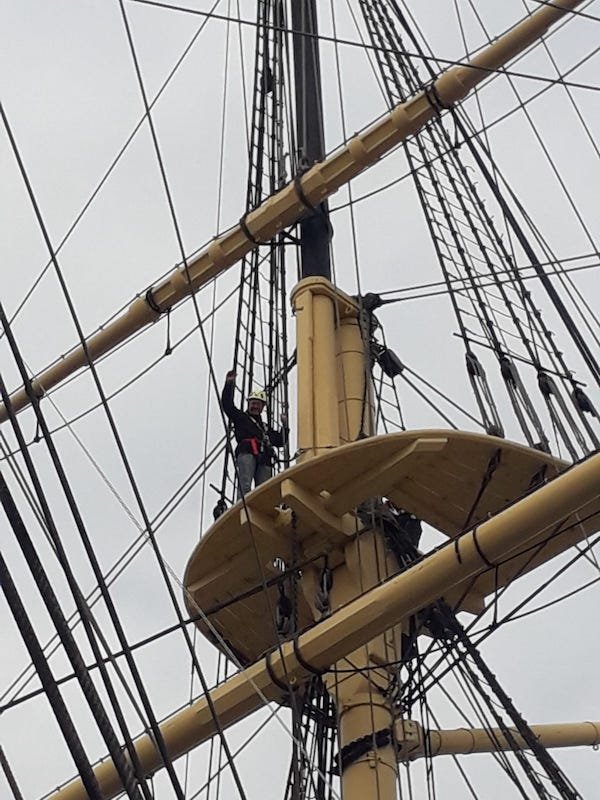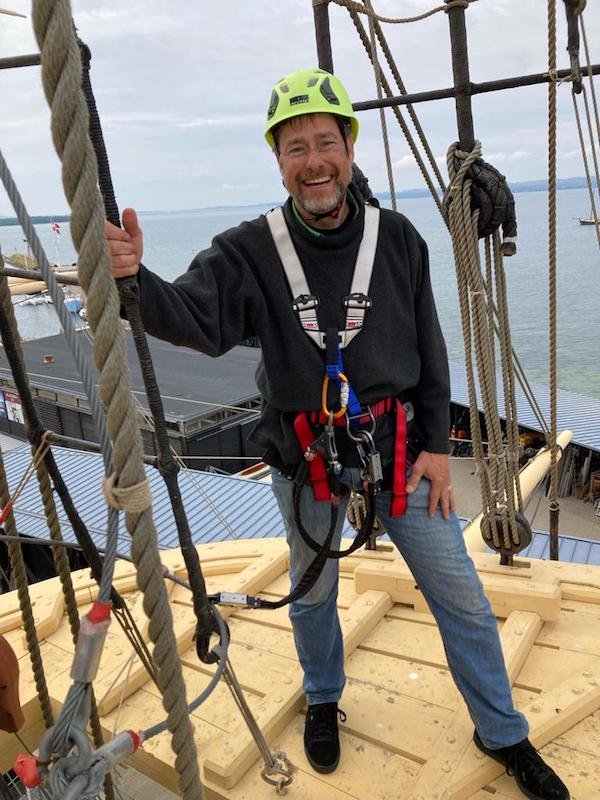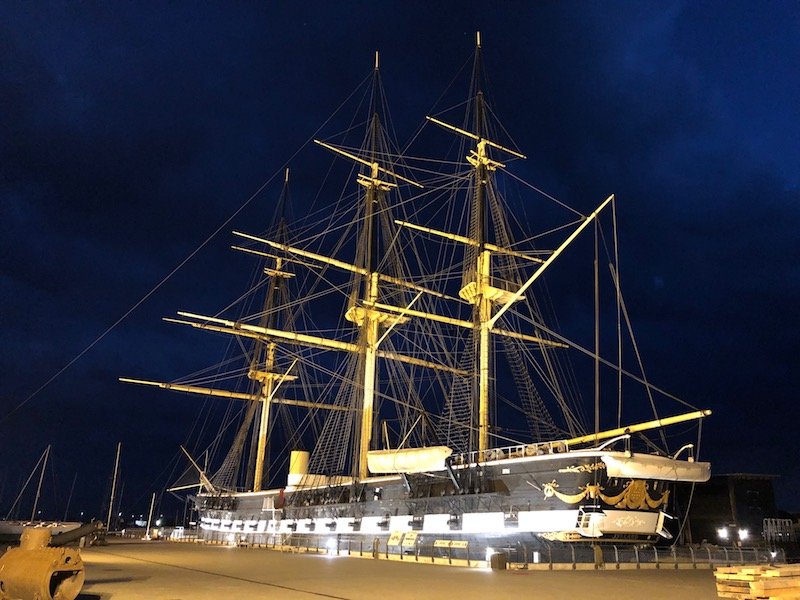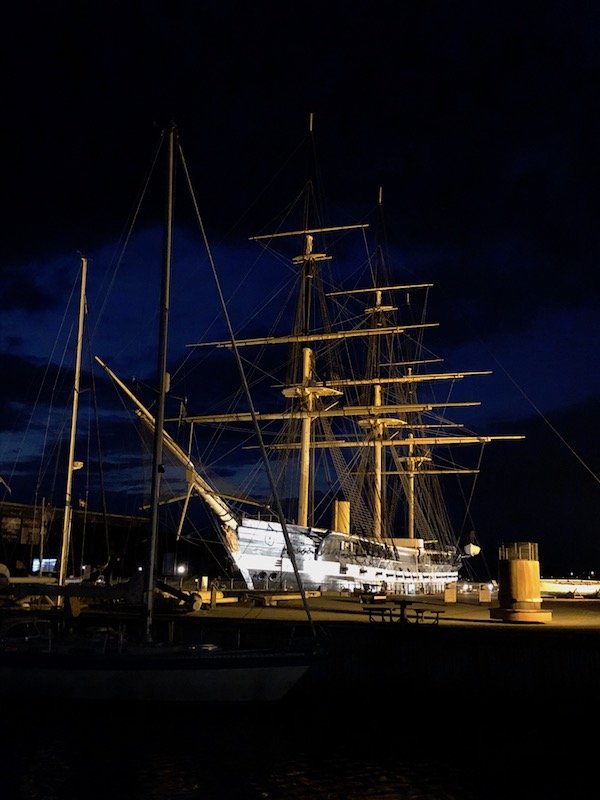-
Posts
2,426 -
Joined
-
Last visited
Content Type
Profiles
Forums
Gallery
Events
Everything posted by dafi
-
And on it went in the text, or rather with the man glitter. First attempt at the substructure of the upper deck. I still changed it afterwards. Then the planks were caulked: Glued vertically on a duct tape and brushed with thicker paint, gives exactly the right width for the scale. Freshly glued, it looks like newly tarred ... ... and after holystoning already a bit more "shipshape" http://www.shipmodels.info/mws_forum/images/smilies/icon_smile.gif Adjusting the height of the Carronade ... ... and fitting test. Fits, so close and put the gunwale on http://www.shipmodels.info/mws_forum/images/smilies/icon_smile.gif Enjoy http://www.shipmodels.info/mws_forum/images/smilies/icon_smile.gif And to show the size ... ... in this sense, all the best, DAniel
- 58 replies
-
- Revell
- Constitution
-
(and 1 more)
Tagged with:
-
*looking surprised* "Shelf? What shelf?". *looking surprised* XXXDAn
- 58 replies
-
- Revell
- Constitution
-
(and 1 more)
Tagged with:
-
Never even I know where my brains will go, there were small voices that told me: "take that wood and build ..." My wife is missing that old shelf she inherited from her anceseters, hope she does not get too souspicious ... XXXDAn
- 58 replies
-
- Revell
- Constitution
-
(and 1 more)
Tagged with:
-
When the little wood hunger strikes ... ... then there it comes, the man´s glitter ... ... or dafi goes stray 😉 First of all I made a small deck, the size of a matchbox ... Then I put a round sander into the stand drill and worked out the frame shape. After I had to look for my workpiece 3 (!) times in the hoover bag, a perforated plate was placed in front of the hoover´s tube! Then I glued 4 blanks with double sided tape on top of each other and sanded them as one piece into the frame´s shape. A quick check - yup, it fits. Made a jig out of polysterol strips so that everything can be glued at right angles ... ... and after curing the next fitting test. Meanwhile, the gun visits its new home. The barrel is in the center - yup it fits too So I glued on the planks on the inside, from bottom to top according to Marquardt: Waterway, then Spirketting, Ceiling, Thick Stuff below Clamp and Clamp. And then also closed the planking on the outside And yes, here they come, the inevitable: the 1 cent piece and the TicTac 😉 Best regards, Daniel
- 58 replies
-
- Revell
- Constitution
-
(and 1 more)
Tagged with:
-
Man´s glitter! Well, after more than half a year I finally came back to my man cave and was able to do something. Man did I miss that! In the meantime I was able to hatch some great ideas, so I dug out a matchbox ... ... and used it as the basis for a small pre-model. As usual, it's about being able to try out a few small things. Esepcially again and again about the use positions of the carronades. The guns are also slowly coming into the home stretch. It's always good to be able to keep an eye as a model builder on the programmer. The printing supports have been optimised so that the parts can be removed with as little reworking as possible, and the model construction itself also leads to details being improved in order to make them easier to paint. Here is the 24-pounder. Beautiful details like the coin´s handle and the retaining cord of the stool bed are just great to look at, as are the fittings on the underside - just too bad they are mostly hidden. Meanwhile, for the carronade, I decided to leave the barrel in one piece with the upper carriage. Because of the height adjustment screw, changing the elevation was difficult to adjust anyway or would have been too fragile. The swivel radius of the skeat around the pivot pin, the sliding way and rotation of the upper carriage were kept. And here's a little family picture. And then came the man´s glitter. XXXDAn
- 58 replies
-
- Revell
- Constitution
-
(and 1 more)
Tagged with:
-
Wonderful build and great discussions, I love it, congratulations! The main sheet tackle spreader was not introduced until quite a while after Trafalgar. That is why I omitted it in the etch set. I am not sure but I think it was also taken of the ship a while ago. Just have the eyebbolt on the hull, a length of tackle and that is it 🙂 All the best, DAniel
-
Hello Bill, thank you for the question. Have to think. I vaguely remember that there was an issue with the diameter of the provided spars, that made me give different diameters of the rings to find the right size. Stupidly I did not document this in the instructions ... As far as I know, all stun´sails were up at Trafalgar But there were no stun´sail at the main yard as these were not issued any more after an admirality order from 1801 (Lees). This also means, that the spars on the main channels are most possibly for the fore yard stun´sails. But still have to see if my memory does not play me tricks for the different sizes of rings. All the best, DAniel
-
Hello Bill, I do not know the color of the printed blocks, but if they are black I just applied a light-brown drybrush on them. It looked much better than a complete coat as the coöor has a bit of variances, just like the wooden ones do. All the best, DAniel
-
In parallel, I continued with the periphery of the guns. A first test of the blocks was still a bit too big, but the brown drybrushing did as expected a good job. Therefore the whole thing was redaone a little smaller. Surely another 20% smaller is possible. Note the one double block in the "C" of "Cent" 🙂 And then the question, are they also rigable? Oh yes we can! Here again the dimensions of the smallest, scale was my thinnest rope in 1:100: Thereupon tried some sizes ... ... and the 3 hottest candidates on the model. I then reworked the rigged version with the smallest blocks a bit. Looking at the picture ... ... and realized, crap, the lanyard is twisted. I did not see that in the original, despite strong magnifying glass. So the whole thing decuddled and it fits much better. XXXDAn
- 58 replies
-
- Revell
- Constitution
-
(and 1 more)
Tagged with:
-
Captn dafi supplement: After my computer was in a reconvalescent home for a few days due to an "eternal boot loop", here's what's been happening lately. Last status was that I ran out of planks. New planks were cut, the old Ikea-shelf has become a bit smaller again http://www.shipmodels.info/mws_forum/images/smilies/icon_wink.gif Meanwhile the deck is finished and test fitted. Even with guns this fits http://www.shipmodels.info/mws_forum/images/smilies/icon_smile.gif But in the manger area I had to discover that the deck stands up a bit. But a bit of finger pressure ... ... was remeding it and tamed it and it should be not a problem. While I was at this, I noticed that the entire hull was also totally warped. Midships there was a gap of almost 5mm on both sides in the battery deck. And I had done nothing that could have provoked this - no paint, no glue, no other immoral things that could have sprung from a sick modeler's brain. Hence some bondage ... ... to eventually discover huge gaps on the spar deck aft as well. More bondage then this means. So with this realized, this is truly no longer a shake and fit kit. After that a careful look inside http://www.shipmodels.info/mws_forum/images/smilies/icon_smile.gif At least this fits reasonably well. Here at the upper deck the carronades of the kit ... ... and then in comparison the English classics from 1795. And from close up you can see the possibilities of the new modular construction http://www.shipmodels.info/mws_forum/images/smilies/icon_smile.gif Even from the outside, the guns give a completely different picture than the kit parts. XXXDAn
- 58 replies
-
- Revell
- Constitution
-
(and 1 more)
Tagged with:
-
Great work and tremendeous speed! For the rope sizes consult the AOTS MacKay, but take care, the dimensions are in circumderence and not diameter! Scale down the different sizes to about 5 different ones, that will do the job imho. All the best, DAniel
-
I had already used this technique on my Victory. Here on the left is the picture from which my avatar comes and next to it a picture of the lower deck of the Vasa Coming in the right direction for me. Just a 100 times smaller 😉 XXXDAn
- 58 replies
-
- Revell
- Constitution
-
(and 1 more)
Tagged with:
-
So, I continued with some gardening. When gluing, finger cots are recommended, just cut off the tips of an old rubber glove and put them on again individually ... ... but how do I get all the cherry blossoms off the deck afterwards? After gluing, the whole thing looks very messy at first, so I first go over it with the scraper to remove the worst of it. Then comes the sanding block with the coarse 40 grit sandpaper ... ... then the 80 grit and individual planks that are sitting too low are scraped off with the thin chisel. Here are the two states side by side ... ... but slowly it becomes a deck ... ... if I hadn't run out of planks http://www.shipmodels.info/mws_forum/images/smilies/icon_wink.gif Happy Easter! XXXDAn
- 58 replies
-
- Revell
- Constitution
-
(and 1 more)
Tagged with:
-
And the next step was planking the deck. The adhesive foil is placed on the black side and the foil is carefully peeled off ... ... the planks with the black side down are glued on with superglue ... ... and then sanded to the same height with 80-grit sandpaper. And the parquet is finished. And now diligence work for the rest of the deck. XXXDAn
- 58 replies
-
- Revell
- Constitution
-
(and 1 more)
Tagged with:
-
Thank you Eduard, watch this space, who knows 😉 Meanwhile the hopefully final version of the long guns came out of the printer. All the important details are in place, including the cap square key and the coins's handling cord . Also, the supports are now all in such a way that the part almost falls out by itself after printing and hardly any rework is needed. If you cut out the coin and the stool bed, the gun can also be secured well over the port. But other positions also are possible 😉 Parallel to that I cut planks, glued them on self adhesive foil ... ... and sprayed it black. More about this soon. Then the grain structure of the decks was smoothed with sandpaper ... ... and I marked the approximate position of the deck beams underneath. Even if the position of the passages to the orlop deck do not quite match the plans, the concept could be transferred. These beam lines form the alignment of the plank joints, as these had to be nailed into something, as in between the beams the nails would have hung in thin air 😉 Best regards, DAniel
- 58 replies
-
- Revell
- Constitution
-
(and 1 more)
Tagged with:
-
Hello Tom, nice to see you here! Great start and keep on having fun modeling, that is all it is about 🙂 All the best, Daniel
About us
Modelshipworld - Advancing Ship Modeling through Research
SSL Secured
Your security is important for us so this Website is SSL-Secured
NRG Mailing Address
Nautical Research Guild
237 South Lincoln Street
Westmont IL, 60559-1917
Model Ship World ® and the MSW logo are Registered Trademarks, and belong to the Nautical Research Guild (United States Patent and Trademark Office: No. 6,929,264 & No. 6,929,274, registered Dec. 20, 2022)
Helpful Links
About the NRG
If you enjoy building ship models that are historically accurate as well as beautiful, then The Nautical Research Guild (NRG) is just right for you.
The Guild is a non-profit educational organization whose mission is to “Advance Ship Modeling Through Research”. We provide support to our members in their efforts to raise the quality of their model ships.
The Nautical Research Guild has published our world-renowned quarterly magazine, The Nautical Research Journal, since 1955. The pages of the Journal are full of articles by accomplished ship modelers who show you how they create those exquisite details on their models, and by maritime historians who show you the correct details to build. The Journal is available in both print and digital editions. Go to the NRG web site (www.thenrg.org) to download a complimentary digital copy of the Journal. The NRG also publishes plan sets, books and compilations of back issues of the Journal and the former Ships in Scale and Model Ship Builder magazines.

